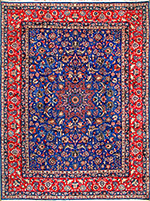Textiles Studies

Textile Research Works
Date of this Version
2000
Document Type
Article
Citation
Middle East Studies Association Bulletin , Summer 2000, Vol. 34, No. 1 (Summer 2000), pp. 56-58
Abstract
Review of: Geometric Patterns from Islamic Art & Architecture, by Robert Field. Tarquin Publications, Norfolk, UK, c1998. AND "The Nature of Islamic Ornament, Part III: Geometric Patterns," exhibition on view March 17-July 18, 1999 in the Hagop Kevorkian Fund Special Exhibitions Gallery at The Metropolitan Museum of Art.
Circles of equal radius, when tight-packed, naturally combine in two ways. One method yields centers that form a triangular grid; the other method yields centers that form a square grid. These basic mathematical considerations underlie the play of pattern in Islamic art. By selecting centers in a triangular grid, one may establish a rhombic grid or a hexagonal grid. By connecting centers to form lines and angles, or highlighting curves, many seemingly complex patterns may be generated from simple algorithms. The triangular grid lends itself to six-pointed stars and hexagons; the square grid may yield eight pointed stars and cross forms. Lines and angles may then be established to create more relationships of stars and polygons. Further connecting lines (and erasing lines) may produce interlaced patterns. Two recent works in different formats but with similar objectives explore aspects of geometry in Islamic art. Robert Field has compiled a sweet little book (6"x81/2") of photographs, diagrams, and commentary called Geometric Patterns from Islamic Art & Architecture. Stefano Carboni has organized a gem of an exhibition (around thirty objects), "The Nature of Islamic Ornament, Part III: Geometric Patterns" at The Metropolitan Museum of Art. Both works, small as they are, seek to present to a broadly conceived public the basic visual components of complex geometric patterns as they occur in Islamic art.
Included in
Art and Materials Conservation Commons, Art Practice Commons, Fiber, Textile, and Weaving Arts Commons, Indigenous Studies Commons, Museum Studies Commons

